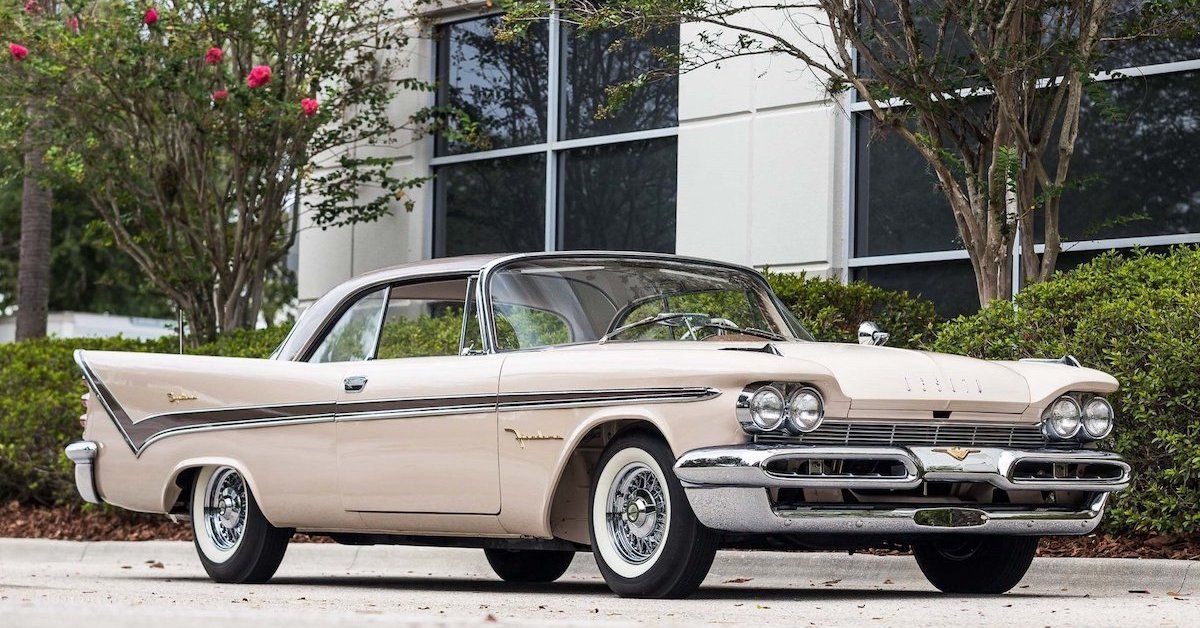DeSoto, a long-dead Chrysler brand that built heavy, unwieldy family vehicles with inline sixes, was losing momentum to the big boys – Cadillac and Oldsmobile – who had begun using V8s in a quest for horsepower supremacy shortly after WWII. When Chrysler opted to install a brand-new 4.5-liter Hemi V8 with 160 horsepower under the hood of the new Firedome, the 1.7-ton monster sped from 0-60 in 15.5 seconds. Slow today, but five seconds faster than anything else on the market at the time, and DeSoto became the standard.
The early years of the American automobile industry were fraught with anxiety. Brands like Chevrolet, GM, and Packard were squeezing their way into the market, and buying lesser Marques was one of the most preferred ways to gain market share. General Motors had LaSalle, Pontiac, Marquette, and Viking, although Chrysler came late to the game, they presented Plymouth, Dodge, and DeSoto in one calendar month in 1928, and the game was suddenly on.
The Firedome, named for Spanish adventurer Hernando de Soto, first appeared in showrooms in 1953. Some quite significant DeSoto Firedome models include 1958 DeSoto Firedome III Two-Door Sportsman (facelift 1958), 1959 DeSoto Firedome III Four-Door Sedan (facelift 1959), 1959 DeSoto Firedome III Four-Door Sportsman (facelift 1959), 1959 DeSoto Firedome III Convertible (facelift 1959), and 1959 DeSoto Firedome III Two-Door Sportsman (facelift 1959).
Now, let's take a closer look at the vintage DeSoto Firedome.
A Spectacular Overview Of How The DeSoto Car Works
When the fast-growing new Chrysler Corporation purchased Dodge and launched its first DeSoto and Plymouth in 1928, prosperity looked limitless. Despite the fact that the good times soon shifted to “hard times,” DeSoto would be one of the few pre-Depression “expansion” manufacturers to survive.
DeSoto went on to produce some of the most thrilling automobiles in the 1950s, only to succumb to a flash recession and sibling competition in late 1960, obliterating its tiny, well-defined price niche. In the interim, DeSoto served as an excellent and occasionally great “bridge” between Dodge and Chrysler, with design and engineering that owed more to the latter than the former.
For 1940, a more appealing Dietrich style was introduced, aided by longer wheelbases of 122.5 inches standard and 139.5 inches extended. On DeSotos, Chrysler’s Fluid Drive became available, allowing the driver to start and stop without engaging the clutch. The custom convertible coupe was brought back, but the convertible sedan was not. Despite an 11,000-unit increase in model-year output, DeSoto was once again ranked 13th. It, like other Chrysler models, could have done better if the company hadn’t been crippled by a strike at the commencement of manufacturing in 1940.
Volume increased for ’41, rising from 65,500 to over 97,000, propelling DeSoto to tenth place, its highest-ever finish. A major makeover resulted in automobiles with lower hoods and bolder fronts, which contributed to their success. The prominent vertical “tooth” that would become a DeSoto trademark through 1955 smiled from the grilles.
The DeSoto Firedome: A Moving Work Of Art
DeSoto Firedome came as a 2-door coupe and convertible, as well as a 4-door sedan and station wagon, and could comfortably seat four people, but the Hemi V8 was the main attraction.
It was the first time Chrysler used an 8-cylinder engine in a car since 1931, and although the term Hemi wasn’t formally used until 1964 — it was trademarked by Chrysler in the early 1960s – the first year of production saw sales of little over 64,000 units. The 1953 Firedome was powered by an engine with ‘excellent performance qualities,’ according to Motor Trend magazine, which was typically understated.
The 1956 model versions were rebuilt utilizing Virgil Exner’s ‘Forward Look’ idea, which featured long hoods and short decks, and a DeSoto was used as the Pace Car for the Indianapolis 500 for the first and only time. The engine was upgraded to a 4.7-liter block with 185 horsepower, and a year later to a 5.4-liter block with 230 bhp. DeSoto outsold Chrysler for the 1956 model year. In 1958, a 5.9-liter Hemi V8 with 295 horsepower was the final version of the now renowned Hemi V8.
However, by the late 1950s, Chrysler was experiencing sales difficulties due to the ‘Eisenhower’ recession, poor management, and rumors that the De Soto brand would be phased out. The Firedome was available in 26 colors and 190 two-tone finishes in 1959, the final year of production, but even that wasn’t enough to salvage the De Soto name, which died on November 30, 1960.
Why You Should Consider Adding A DeSoto Firedome To Your Garage Today
The DeSoto Firedome is a mid-century marvel that you can enjoy with up to three friends, and it’s a great-sounding, smooth cruiser with six distinct body shapes to choose from. The split windshields of the 1952 model may appeal to vintage purists. The styling was changed for the 1953 and 1954 versions, which featured a new body with more chrome and fender lines that ran the length of the vehicle. The grilles on the 1952 and 1954 cars have nine teeth, whereas the grilles on the 1953 cars have eleven teeth.
Notably, the DeSoto Firedome was the company’s mid-range model in 1958, sitting above the entry-level Firesweep but below the more well-equipped Fireflite and Adventurer. Despite its sub-luxury reputation, a 1958 Firedome convertible, one of only 519 made by the carmaker that year, sold for $192,500 (plus a 10% buyer’s premium) at Auctions America’s Auburn, Indiana, cracking the top-10.
Source: Hemming, HowStuffWorks, wheelerdealersdiscoveryUK.


.jpg)
.jpg)
.jpg)